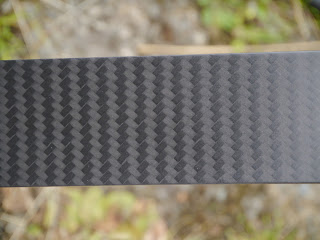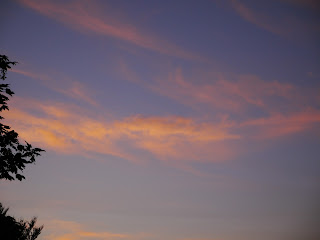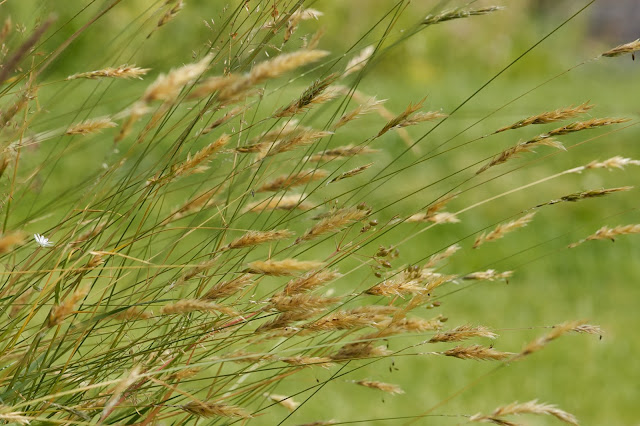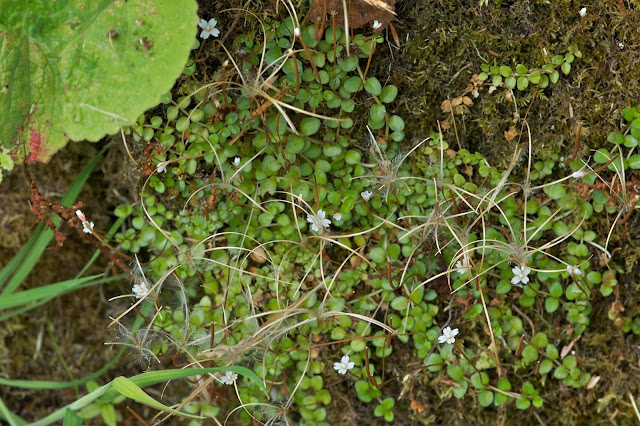The woodshed rose gives way a little to the den rose.
 |
| Den rose |
The aquilegias, chives, irises and pignut give way to foxgloves, yellow loosestrife, triteleia and sage. The honeysuckle blossoms everywhere and the brambles and Peruvian lilies (especially those – they seem to be in their element here) shout out their yellow, their white and their orange splashes.
In the roadside verges the meadowsweet dominates, sometimes mixed in with the yellow of ragwort, making a surprsingly pleasing mix. Patches, sometimes whole fields, glow with rose-bay willow herb. I keep pulling it up in the garden but when I see a glorious patch I wonder whether I'm doing the right thing. The Boggy Brae seems to works best with what nature sows.
 |
| Triteleia and Quaking Grass |
 |
| Triteleia and Quaking Grass |
 |
| Peruvian Lily |
One planting I have done which has succeeded – eventually! taking four years to really settle in and flower – is Everlasting sweet pea (Lathyrus latifolius).
The weather, since it warmed up after a cold spring, has been lovely. After this month's first coolish week, it has been warm, even hot sometimes (max 25.4º in the shade). Real summer weather. This last week we have had some summer thunderstorms – nothing huge – which I enjoy, and the night temperature has been going down to about 11º. Until mid-April even the maximum daytime outdoor temperature didn't get much above that!
The hay (mainly Yorkshire Fog and Crested Dog's Tail grasses) has been harvested from the field, as you can see at the right of the upper sweet pea photograph above. This is the first time in seven years (and probably longer) that this has happened, though three years ago some sheep were in there for a while (sub-let to a shepherd) and, when the grass grew again, some heifers. The farmer called me some eighteen months ago to ask if, according to our house deeds, we had any responsibility for the fence between our garden and the field. I understand that Scottish law says people have to make their property secure from farm animals, rather than requiring the farmer to make sure the animals are secure within his territory. There is nothing in our deeds about responsibility for boundaries so I called him back and told him. I mentioned in passing that heifers or sheep wouldn't do much damage in the Boggy Brae – they might even be quite helpful eating grass and overgrown hedges – but that it was worth his noting we have no gate so any animal that got in would also be able to get out and wander down to the The Road. The farmer's ideas about using the field for animals seemed to cool after that, at least until he has fixed the fences. Still, the hay was good this year and he did get it harvested.
The hay (mainly Yorkshire Fog and Crested Dog's Tail grasses) has been harvested from the field, as you can see at the right of the upper sweet pea photograph above. This is the first time in seven years (and probably longer) that this has happened, though three years ago some sheep were in there for a while (sub-let to a shepherd) and, when the grass grew again, some heifers. The farmer called me some eighteen months ago to ask if, according to our house deeds, we had any responsibility for the fence between our garden and the field. I understand that Scottish law says people have to make their property secure from farm animals, rather than requiring the farmer to make sure the animals are secure within his territory. There is nothing in our deeds about responsibility for boundaries so I called him back and told him. I mentioned in passing that heifers or sheep wouldn't do much damage in the Boggy Brae – they might even be quite helpful eating grass and overgrown hedges – but that it was worth his noting we have no gate so any animal that got in would also be able to get out and wander down to the The Road. The farmer's ideas about using the field for animals seemed to cool after that, at least until he has fixed the fences. Still, the hay was good this year and he did get it harvested.
Toadlet's school vacation adventures
One Saturday when there was no riding lesson we put Toadlet on a train to Edinburgh where her big sister, the Springboard Diver, met her and entertained her for the weekend, including taking Toadlet in to work with her on Monday before putting her on a train back across country.
Another weekend we put Toadlet and a school pal, whom I shall call 'The Innocent', on a Sunday train to Glasgow. Toadlet and Diver had arranged to do this during the Edinburgh weekend and The Innocent tagged along. They did some shopping and then went to view Glasgow Lighthouse. The building that houses it was designed by Charles Rennie Mackintosh. There is some history about it here. I think I need to visit it too!
Mosses and Lichens
I started looking much more closely at the lichens and mosses that grow at the Boggy Brae. Soon realised the books I had were inadequate for any real precision in differentiating species so I treated myself to two new ones:
 |
| Pellia epiphylla close-up |
 |
| Pellia epiphylla on a wall rock |

 New Bow
New Bow
Back in April, I blogged about our visit to Border Bows. What we ordered then has now been made and sent to us. I have a complete new bow and Toad has new limbs. My new bow riser (handle) is a work of art and of modern technology and is made of the woods of jacaranda and walnut plus some carbon fibre for strength.
I shot a few arrows with my new bow and am happy to report a very pleasing thud as they hit the target! This is because the bow shoots the arrows at a greater speed than Bluebow – one of the reasons for the greater recurve of the Border limbs.
 |
| The underside of the riser showing the ply |
 |
| The woven carbon fibre on the limbs |
Lithium batteries by post. A story.
Toad has sold a rather specialised film camera. He'd sold it easily and for a jolly good price on eBay because it is a collector's item nowadays. The camera was in a plastic bag, packed in a box, which was inside another box alongside a second lens, all surrounded by bubble wrap. And all of that was inside another box. Safe then, you'd think.
But when he took it to the post office, the clerk asked him what was in the parcel. Answer: A camera.
Does it have a battery? — Yes.
Is it a lithium battery? — (quick thinking by Toad) No. Silver oxide (though he had no idea why a lithium battery might be a problem).
PO clerk puts his checklist away and the camera is posted.
What is special about lithium batteries? It seems that a very few faulty lithium batteries have overheated and caused fires. The technical details of what happens were interesting but not intricately memorable. You can google it. Anyway, when a lithium battery overheats and starts a fire what the PO calls this is "venting with flame"! What battery manufacturers call it is "rapid disassembly". What common or garden tree-climbing people call it is bursting into flames. The story made me laugh.
So really what Toad should have done is send the camera without its battery. Then the new owner could have bought a new battery from Amazon, which they would send to him by post.
er... Hang on a minute!









































.jpg)